The majority of the country has adopted shelter in place policies, which means many of our daily routines have been disrupted. For Joffrey Ballet dancer Derrick Agnoletti, this means being unable to attend daily ballet class and rehearsals with his colleagues. As a physical therapist, I am adjusting treatment sessions in order to continue to connect with patients safely. Here is some advice for dancers who are similarly adjusting to training at home.
1. Take a class at home, even if it’s at a modified capacity
“I grew up as a swimmer and water polo player in California and started dancing at the suggestion of my waterpolo coach. Upon my first lesson I fell in love with the art form” says Derrick. He trained at San Jose Cleveland Ballet School, San Francisco Ballet School, The Ailey School and School of American Ballet, and in college at UC Irvine, where he also played water polo.
With a natural appreciation for sports and fitness, and dance training specifically, he states, “My most important rule is…TAKE BALLET CLASS. You can cross train to shape your body, increase explosion in your jump, build your core, but taking ballet class, finishing each combo, finishing the class builds a muscle memory like no other. Every bit of the ballet class counts.”
Joffrey Ballet has been live-streaming ballet class taught by their professionals on their Instagram account.
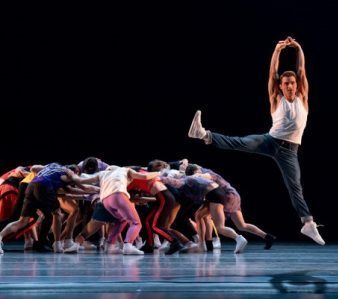
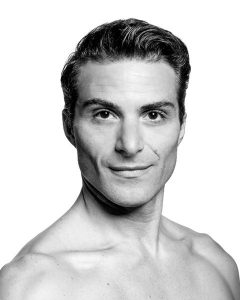
(Photos of Derrick Agnoletti, Joffrey Ballet Company Dancer)
2. Focus on injury management/recovery
During this period of unexpected decrease in frequency and intensity of dance training, dancers should focus on the opportunity to recover from an ongoing injury. Derrick states, “I have been very lucky to continue my [physical therapy] through Athletico as I rehab two minor injuries I have been dealing with. One hour of my home routine [was] prescribed to me by my Athletico [physical] therapists Jen and Rachel.”
Athletico has a group of physical therapists that are highly skilled in treating individuals from the performing arts world. Athletico clinics remain open to assist in essential healthcare services and have also initiated telehealth services to connect with injured dancers to help them in their recovery during this time.
3. Incorporate cross training
Derrick usually cross trains with bootcamp HIIT classes, some yoga, and swimming. He states “Cross training is incredibly beneficial. I cannot stress enough how fitness training has both helped me rehab and also helped me prevent injury.”
I asked Derrick what has been different about cross-training under Illinois “Stay at home” orders and he responded “It is different in the sense that I am not with the people I work out with everyday pushing me along with their incredible energy and drive.” Derrick stays active at home with a mix of cardio, resistance training, and physical therapy. “Every day I try to do an hour of isometrics, mixed with ab work and some heavy resistance training. I also have been trying to go for 3-4 mile jogs with 30 second sprints every 3 minutes to keep my heart rate rising and falling.”
4. Perform cardiovascular exercise
Some dance choreography can be quite aerobic, but a typical ballet class is not. Derrick notes his cross training “has given me an edge in my dancing that most 38 year olds don’t have. When people ask me where my vitality and strength come from in my dancing, I attribute it to the work I have put into my cardiovascular training. Stamina is one thing dancers struggle with as our moments of intense energy come in short waves. As someone that cross trains to get my heart rate to spike for a given period of time, I believe that this has benefitted me. I rarely get winded or tired during a ballet. I find when I hear other people are tired, the algorithm my body is used to on a daily basis is ready to work. Fatigue does happen, but active recovery has helped me understand that a great deal of being tired is mental.”
Going on a brisk walk and stationary biking are two lower impact options that may be appropriate for a dancer who is less experienced with cardiovascular training, or is recovering from an injury. Running can be a safe option for dancers as long as they wear proper footwear, increase their duration or distance gradually, run on alternate days to ensure muscle recovery, and listen to their bodies. The legs are neutrally rotated in an ideal running stride, but dancers are used to working in external rotation of the lower extremities, so this new mechanic works new muscles. Dancers should be mindful of not running in too much rotation as it creates unwanted torque at the knee and ankle.
5. Be smart about your training
Derrick advises, “Never go into something without having an understanding of what you are going to do. If you are a beginning runner, consult a physical therapist or athletic trainer to discuss a plan to get you on a proper running schedule. It is also helpful to have someone look at your running technique.” Common causes of running related injury include repetitive overuse and increasing mileage too quickly.1,2
With weight lifting, performing the right exercises, good form, proper muscle engagement and your core is what makes the cross training effective. Simply pumping weights without a goal and without an understanding of form is dangerous, pointless, and [deprives] you of the maximum benefits. It is recommended to start light when initiating weight training. Water bottles, a backpack weighted with household items, and resistance bands are great at home objects to substitute for typical weights.
6. Target key muscles
Common areas of muscle imbalance in dancers include the glutes, core, and calves (primarily the gastrocnemius and soleus muscles). Use these home-friendly exercises to improve the strength of these muscles. The number of reps and sets are suggested which can be increased or decreased as needed. The goal is to feel some minor fatigue in the muscles you are working.
Single Leg Bridge
Targets: Hamstrings and glutes
Start lying on your back, with one leg bent and the other leg extended. Tighten your abdominals, push through your heel, and squeeze your glute as you bridge your hips and torso up into position shown here:
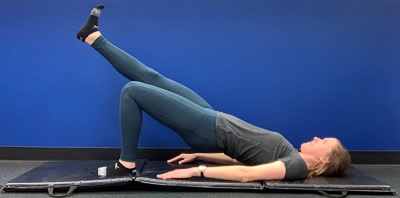
Pause for a second or two at the top, and then lower hips down. Repeat. Perform 2-3 sets of 10
Side Plank with Resisted Clam
Targets: Abdominals, obliques, hip abductors, and hip external rotators
Start lying on your side with your knees bent and resting on your forearm. Bridge your hips and torso up into a side plank. Then lift your top knee up. Pause, then lower knee down and repeat.
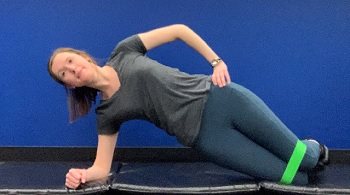
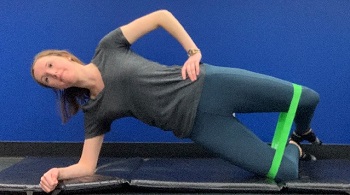
Perform 2-3 sets of 10-15 reps
Plank with Alternating Leg Taps
Targets: Abdominals, obliques, hip abductors, upper body
Start in a plank on hands and toes, with abdominals engaged and feet together. Tap the toes of your right foot out to the side as pictured. Then bring leg back in so feet are touching. Repeat with left leg to left side. Continue alternating.
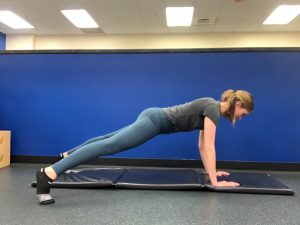
Perform 2-3 sets of 6-8 taps with each leg.
Airplanes
Works: Spinal stabilizers, the posterior chain, eccentric control, balance
Start standing with your feet together. Engage your abdominals, shift weight onto one leg, then hinge forwards at your hips. Squeeze the glute of your lifted leg to engage the posterior leg. The goal is to get your torso and extended leg parallel to the floor. Try to keep both legs in neutral rotation. Return to standing upright. Repeat. Avoid hyperextension of your standing knee.
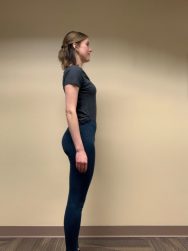
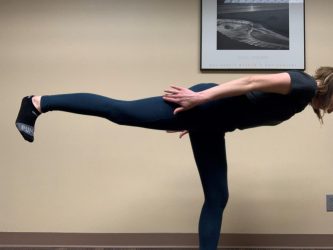
Repeat 2-3 sets of 8 reps
Single Leg Relevé
Perform these with your standing leg in parallel to increase your calf strength (gastroc and soleus muscles) and work on equal recruitment of your ankle stabilizers. The ability to perform 25 repetitions on each leg appears to be associated with reduced foot, ankle and calf muscle injury occurrence.3
Athletico is a proud partner as the Official Provider of Physical Therapy Services to The Joffrey Ballet. To learn more about our performing arts rehabilitation services, contact us at PerformingArts@Athletico.com.
The Athletico blog is an educational resource written by Athletico employees. Athletico bloggers are licensed professionals who abide by the code of ethics outlined by their respective professional associations. The content published in blog posts represents the opinion of the individual author based on their expertise and experience. The content provided in this blog is for informational purposes only, does not constitute medical advice and should not be relied on for making personal health decisions.
References:
1. Van der Worp, Maarten P et al. “Injuries in runners; a systematic review on risk factors and sex differences.” PloS one vol. 10,2 e0114937. 23 Feb. 2015, doi:10.1371/journal.pone.0114937
2. Van Gent RN, Siem D, van Middelkoop M, van Os AG, Bierma-Zeinstra SM, Koes BW. Incidence and determinants of lower extremity running injuries in long distance runners: a systematic review. Br J Sports Med. 2007;41:469-480; discussion 480. http://dx.doi.org/10.1136/bjsm.2006.033548
3. Pilcher, Lara Bianca. “Why the Australian Ballet Dancers Quit Stretching.” Dance Informa. September 2019
Kathleen Warner was a physical therapist at Athletico Physical Therapy at the time of this blog.

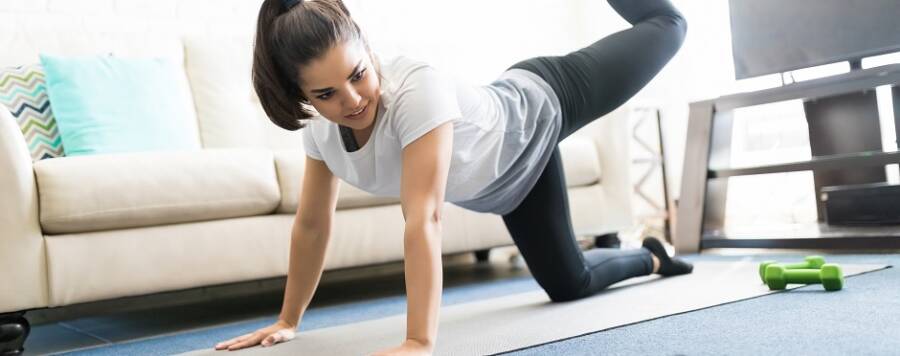 width="900"
height="356"
>
width="900"
height="356"
>

5 Comments
Joseph
Thanks for great tips, I will start applying them.
Giovanna
You have something maybe less advanced I just started recovering from a stroke with my APT the one from tzora this one.. What are the next steps after
Athletico
Hi Giovanna, here are some fundamental workouts you can do at home with some items you may have around the house: https://www.athletico.com/2020/04/06/workout-at-home-with-these-household-items/
Tuyet-Hanh
Much needed one in this quarantine. Keep doing your wonderful work.
Jack Evens
Awsome – this gave me so much clarity